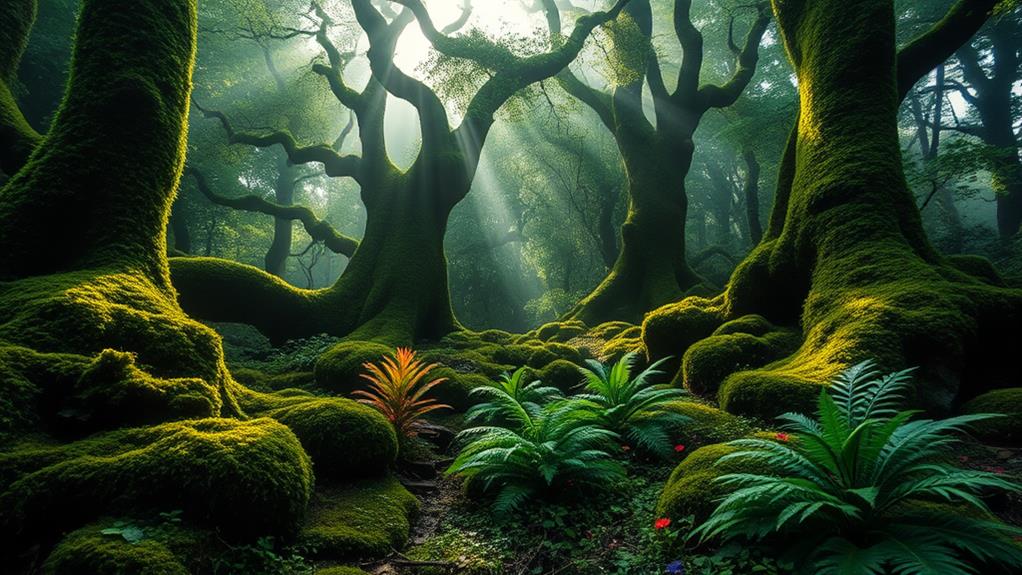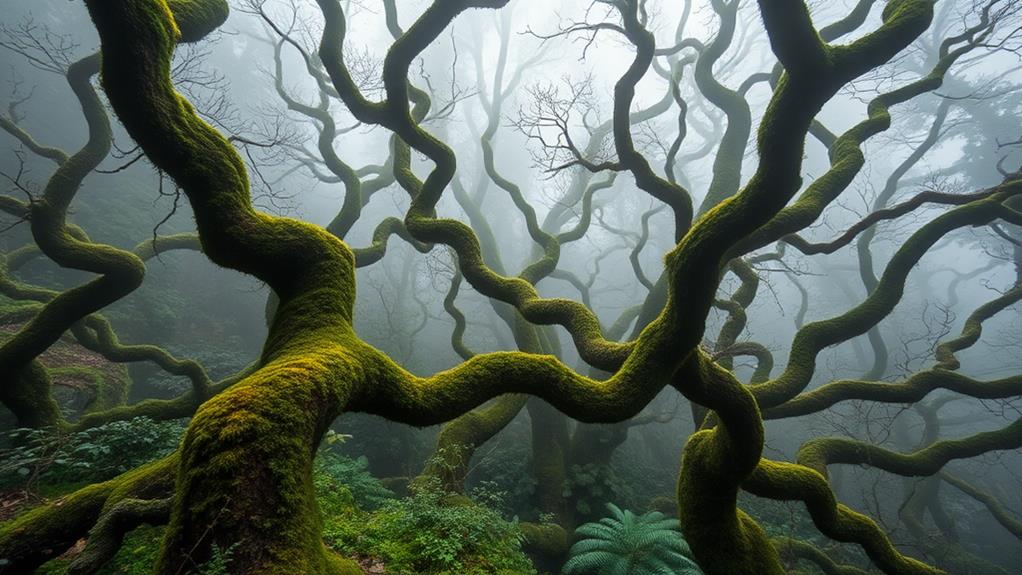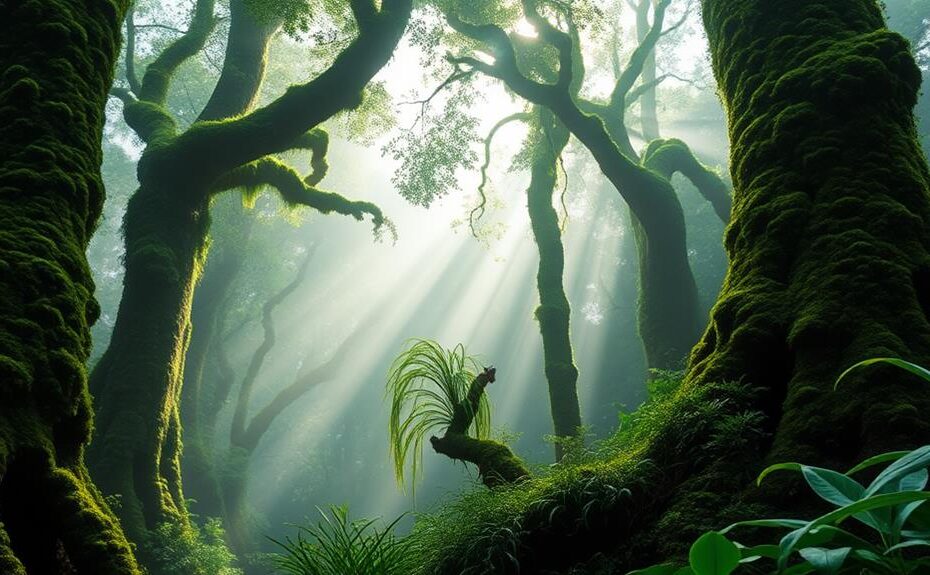Mossy forests, also known as cloud forests, exist at elevations between 500 m and 4000 m. These unique ecosystems thrive in dense fog, creating an environment that supports a wide range of plant and animal life.
The resplendent quetzal and various orchid species are examples of the many endemic species found in mossy forests.
Annual rainfall in mossy forests varies greatly. This variability enhances moisture retention through fog drip, a process crucial for the survival of plants and animals in these ecosystems.
Fog drip occurs when fog condenses on leaves and drips down to the roots, providing a steady water supply.
Climate change poses a significant threat to mossy forests. As temperatures rise, suitable habitats for these ecosystems are reduced, increasing the risk of extinction for the unique species that inhabit them.
Conservation efforts are essential to protect mossy forests and their inhabitants.
Overview of Mossy Forests

Mossy Forests: Unique Ecosystems with High Biodiversity
Mossy forests, also known as cloud forests, are fascinating ecosystems shaped by their unique climatic conditions. They exist at elevations ranging from 500 m to 4000 m above sea level, creating a microclimate that fosters diverse flora and fauna.
Annual rainfall varies from 500 to 10,000 mm, and mean temperatures range between 8°C and 20°C, making them hotbeds of biodiversity.
These ecosystems exhibit high levels of endemism, hosting numerous species not found elsewhere. For example, various orchids, epiphytes, and rare animals like the resplendent quetzal and the Andean spectacled bear can be found in mossy forests.
The structure of mossy forests is marked by shorter trees featuring dense stems and gnarled trunks, creating a labyrinthine environment often rich in mosses and lichens.
Globally, mossy forests make up only about 1% of woodland area, primarily concentrated in tropical regions, including Central and South America, East and Central Africa, and Southeast Asia.
This limited distribution highlights their ecological significance and vulnerability, underscoring the need for conservation efforts to protect these unique ecosystems.
Climate and Hydrology
In cloud forests, the combination of climate and hydrology creates a unique environment that supports high biodiversity. These ecosystems thrive at elevations between 500 m and 4000 m, where moisture-laden air rises and cools, leading to persistent fog. This process enhances the hydrological cycle, allowing for significant moisture retention.
Cloud forests have several key features that contribute to their unique environment:
Fog drip occurs when moisture condenses on leaves and drips to the ground, increasing water availability.
Variable precipitation is another characteristic, with annual rainfall ranging from 500 to 10,000 mm, which profoundly influences local ecosystems.
The high storage capacity of tree canopies intercepts precipitation, contributing to moisture retention.
The climate in these regions is characterized by mild temperatures, typically between 8 to 20°C (46.4 to 68°F).
Although tree canopies evaporate about 20% more moisture than non-cloud forests, phenomena like cloud-stripping can effectively double rainfall during dry spells.
This intricate relationship between climate and hydrology not only sustains endemic species but also underscores the importance of these unique ecosystems in maintaining ecological balance.
Biodiversity and Endemic Species

Cloud forests are biodiversity hotspots, supporting a vast array of unique and endemic species. These habitats, characterized by consistent moisture and mist, are home to a diverse range of life forms. For example, the resplendent quetzal and the endangered yellow-tailed woolly monkey are found in these forests.
Peru's cloud forests alone are home to over one-third of its 270 endemic vertebrate species. This underscores the ecological significance of these habitats. Additionally, unique amphibians like the Ecuadorian rain frog thrive in these high-humidity environments.
Epiphytes, including mosses, ferns, and orchids, are abundant in cloud forests. In Ecuador, there are approximately 4,000 orchid species, with 1,300 of these being endemic. This remarkable biodiversity is crucial for maintaining ecological balance and supporting various life forms.
However, cloud forests are under threat due to global warming. Their coverage has drastically reduced from 11% in 1970 to just 1% today. This threatens the survival of countless endemic species and the intricate relationships within these ecosystems.
Preserving cloud forests is essential for sustaining their unique biodiversity.
Distribution and Conservation Status
Cloud Forest Distribution and Conservation Status
Distribution: Cloud forests cover only 1% of global woodlands, spanning approximately 736 identified sites across 59 countries. In Latin America, there are around 280 cloud forest sites, with Venezuela and Mexico hosting the highest concentrations.
Conservation Status: Despite their ecological importance, cloud forests face severe conservation challenges.
Between 2001 and 2018, about 2.4% of these habitats were lost globally, primarily due to human activities. Although roughly 327 sites enjoy some form of legal protection, many remain vulnerable to exploitation.
Ecological Significance: Cloud forests are crucial for biodiversity, supporting rare, endemic species that thrive in the moisture-laden air. The whisper of wind through the foliage echoes the vital role these ecosystems play in maintaining rich biodiversity.
Conservation Efforts: The conservation status of cloud forests is precarious, and immediate efforts are essential to preserve their unique biodiversity and ecological functions.
Impact of Climate Change

Mossy Forests Face a Dire Future Due to Climate Change
Mossy forests are experiencing devastating effects from climate change, threatening the delicate balance of their ecosystems. By 2045, suitable habitats are predicted to decline by 60-80%, mainly due to rising temperatures and reduced cloud cover.
This disruption to hydrological cycles causes ecosystem drying, putting moisture-dependent species at risk. In regions like Xalapa, Mexico, the number of fog days has drastically decreased from 240 to 70 per year, significantly reducing moisture availability.
This reduction puts immense pressure on endemic species that rely on high humidity, such as epiphytes and specific amphibians, which face wilting and potential extinction as their habitats become inhospitable.
The increasing frequency of natural disasters, like hurricanes, further devastates cloud forests, compounding the habitat loss. The potential extinction of up to 37 vertebrate species in Mexico highlights the urgent need to address the impacts of climate change.
It's essential to recognize that the loss of cloud cover directly correlates with the survival of mossy forests and their diverse inhabitants.
Conservation Efforts and Initiatives
Urgent Conservation of Mossy Forests
The alarming decline of mossy forests due to climate change has made conservation efforts a top priority. These ecosystems, which once covered 11% of tropical forests, now account for only 1%.
Key Conservation Initiatives
Organizations like the Cloud Forest Conservation Coalition (CFCC) and the Royal Society for the Protection of Birds (RSPB) are leading the effort to preserve cloud forests through research and advocacy.
These initiatives focus on:
Engaging Local Communities
* Harnessing indigenous knowledge for sustainable practices, such as traditional forest management and agroforestry.
Implementing Protection Measures
* Establishing formal protection for at least one-third of global cloud forests, like national parks and wildlife reserves.
Promoting Global Cooperation
* Supporting international frameworks like the UN Convention on Biological Diversity to coordinate conservation efforts worldwide.
The Urgency of Individual Involvement
Despite these efforts, deforestation and climate change continue to threaten mossy forests.
Your involvement is crucial to mitigate biodiversity loss. By advocating for biodiversity conservation and supporting local initiatives, you can make a difference.
Successful conservation requires a collective effort, combining scientific research with grassroots activism to ensure these unique ecosystems thrive for future generations.
Questions and Answers
What Is the Mossy Forest Ecosystem?
The Mossy Forest Ecosystem: A Hub of Biodiversity
The mossy forest ecosystem is characterized by its remarkable biodiversity, with unique flora and fauna adapted to its specific climate and geography. This ecosystem thrives in cool, humid conditions, supporting various plant species like epiphytes that grow on other plants, and ferns that thrive in shady areas.
Threats to the Mossy Forest Ecosystem
Mossy forests face two major threats: deforestation and climate change.
Deforestation leads to the destruction of habitats, while climate change alters the ecosystem's delicate balance. Conservation efforts are crucial for restoring these habitats and ensuring their survival.
Conservation Efforts
Research and responsible tourism can promote awareness and support necessary conservation initiatives.
What Is the Cloud Forest Ecosystem?
Cloud forests are unique ecosystems characterized by high moisture retention and exceptional biodiversity. These ecosystems support a wide variety of plant and animal species that can be found nowhere else in the world.
They are home to numerous endemic species, which are species that are native and exclusive to these habitats.
Cloud forests play a crucial role in regulating the climate and storing carbon. They absorb and store significant amounts of carbon dioxide from the atmosphere, making them an essential component in the fight against climate change.
Their preservation is vital for maintaining global biodiversity, as they provide habitat for a diverse range of plant and animal species.
Unfortunately, cloud forests face significant threats, including habitat fragmentation and human activities such as deforestation and agriculture.
These activities lead to the destruction of habitats, resulting in the loss of biodiversity and ecosystem disruption.
Conservation efforts are necessary to protect these ecosystems, ensuring their preservation for future generations.
Why Are Cloud Forests Unique Biomes?
Cloud forests are unique biomes due to their persistent cloud coverage and high humidity levels. These conditions create ideal environments for biodiversity hotspots, where numerous endemic species thrive. For example, the cloud forests of South America are home to the Andean spectacled bear, which is found nowhere else on Earth.
The temperature variations in cloud forests support diverse life forms. In the Monteverde Cloud Forest in Costa Rica, the temperature ranges from 12°C to 18°C (54°F to 64°F), allowing for a wide variety of plants and animals to coexist.
Cloud forests also play a crucial role in carbon storage and soil composition, which are essential for climate resilience. The forests absorb and store carbon dioxide, reducing greenhouse gases in the atmosphere and mitigating the effects of climate change.
Despite their importance, cloud forests face conservation challenges, such as deforestation and habitat fragmentation. To preserve their rich biodiversity and ecological functions, focused conservation efforts are necessary.
What Animal Is Only Found in Cloud Forests?
The resplendent quetzal is an animal found only in cloud forests. This species showcases remarkable adaptations to thrive in these unique ecosystems. For example, its vibrant plumage and long, flowing tail feathers help it blend in and attract mates in the misty, humid environment.
Cloud forests act as biodiversity hotspots, harboring critical species interactions that maintain ecological significance. These forests support a wide range of plant and animal life, including the resplendent quetzal, which relies on the forest's fruit trees for food.
However, habitat loss due to climate change threatens the survival of these species. Rising temperatures and changing precipitation patterns alter the delicate balance of the ecosystem, putting the resplendent quetzal and other cloud forest dwellers at risk.
Conservation efforts are vital to protect these delicate forest ecosystems, ensuring the continued survival of these extraordinary animals in their natural environments.
